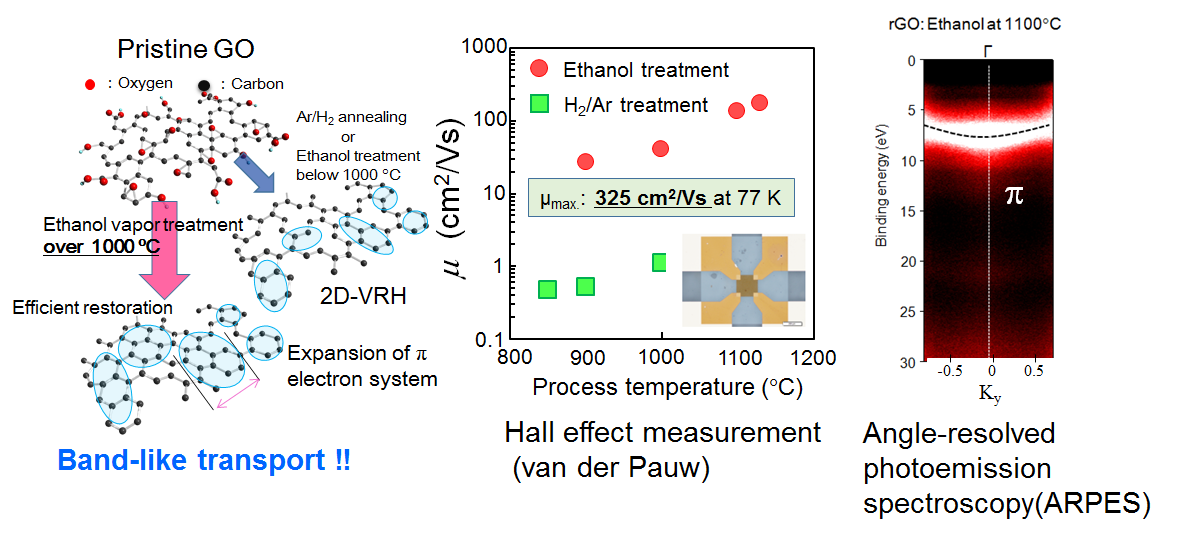Resrach
A promising route to the scalable production of highly crystalline graphene films

Researchers discovered a procedure to restore defective graphene oxide structures that cause the material to display low carrier mobility. By applying a high-temperature reduction treatment in an ethanol environment, defective structures were restored, leading to the formation of a highly crystalline graphene film with excellent band-like transport. These findings are expected to come into use in scalable production techniques of highly crystalline graphene films.
Publications:R. Negishi et. al., Scientific Reports (2016). R. Negishi and Y. Kobayashi APL (2014).
Synthesis of the turbostratic multilayer graphene nanoribbons

The GNR has various excellent electrical properties. Especially, the gap opening due to electron confinements and edge effects in very narrow GNRs (-10 nm) leads us to expect their future applications to functional devices. According to theoretical calculations, a multilayer GNR (multi-GNR) with turbostratic structures has a band structure similar to that of single-layer graphene with a linear dispersion due to very weak interaction between graphene layers. This feature is ideal for high-performance field effect transistors with both high carrier mobility and high On/OFF ratio. Multi-GNR less than 20 nm wide was synthesized by the overlayer growth of graphene on a GNR template. The very narrow template GNRs with width around 10 nm were prepared by unzipping from double-walled carbon nanotubes. Additional 4-5 layers of graphene were successfully formed on the pristine GNR template by chemical vapor deposition.
Publications:R. Negishi et al., JJAP (2012), JJAP (2011), Thin Solid Films (2011) [Citation:17], H. Tanaka et al., Scientific Reports (2015).
Nanogap electronics for quantum devices

We have developed and tested a new method of fabricating nanogaps using a combination of self-assembled molecular and electron beam lithographic techniques. The method enable us to control the gap size with an accuracy of approximately 2 nm and designate the position where the nanogaps should be formed with high-resolution patterning by using electron beam lithography. We have demonstrated the utility of the fabricated nanogaps by measuring a super conductive single electron tunneling phenomena though dodecanethiol-coated Au nanoparticles placed in the Al nanogap.
Publications:R. Negishi et al., APL (2006) [Citation:35], APL (2007) [Citation:20], Surface Science (2007) [Citation:13], J. Vacuum Society Japan, (2008) Invited
>Development of field effect transistor using graphene nanoribbon as channel

Graphene nanoribbon (GNR) with narrow width less than 10 nm has attracted considerable attention because its electronic structure has sufficient band gap for room temperature transistor operation. According to theoretical calculations, multilayer GNR with turbostratic stacking is an ideal channel material for high-performance field effect transistors (FETs) with both high on current and high on/off ratio. We achieve to fabricate the turbostratic multilayer GNR with narrow width by graphene layer growth on the unzipped single and bilayer GNR as a growth template.
Development of high sensitive biosensor using reduced graphene oxide films as transducer

Reduced graphene oxide (rGO) films functionalized with linker molecules that bind the specific antibodies to the surface of their films are useful for the biosensor based on field effect transistors. Controlling the density of linker molecules on the rGO channel surface is a crucial issue for improving the sensor structure with desired sensitivity and stability. In this study, ultraviolet visible (UV-vis) absorption spectroscopy was utilized for the evaluation of density of linker molecules adsorbed on the rGO and GO surfaces. We revealed that the density of adsorbed linker molecules on the rGO surface is dominated by oxygen-containing groups slightly remaining on the surfaces, rather than restoration of π-conjugated system in graphitic structure of the rGO. We demonstrate that the difference in the density of adsorbed linker molecules on the rGO significantly effects on the sensitivity of the sensor response
Patents:根岸 良太 他、特願2014-172628, 特願2013-105560

